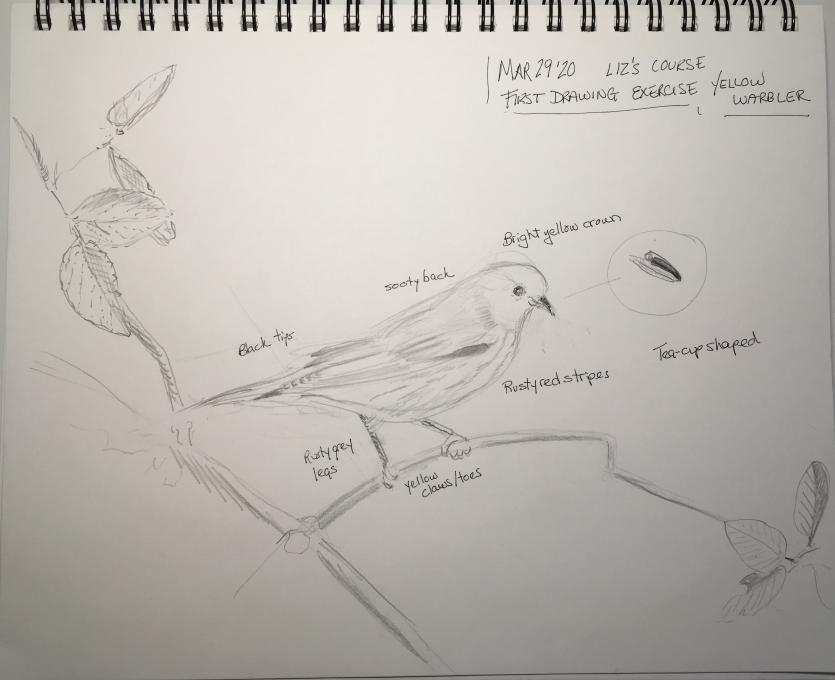The Cornell Lab Bird Academy › Discussion Groups › Nature Journaling and Field Sketching › Jump Right in!
-
Getting the shape right was challenging. (I’m used to doodling where shapes appear and then are Developed). Watercolors got muddled I lost the beautiful yellow. Didn’t figure ou how to paint background. Yesterday never got foto to show up, get inserted. Will try again today

-
 First a note to my fellow students who have replied. I am truly inspired to learn where you are and why you are taking the class. Thank you, all of you, for sharing your thoughts. It's so exciting to know we are from all over the world and sharing this connection. May you fare well in this surrealistic time.
It is very reassuring and inspiring to see everyone’s work!
I enjoyed drawing from the photo. I drew on 4 different days. First a sketch, next a background watercolor wash. Then I did two days of green and yellow. The original pencil helped with some grey tones on the shoulder and parts of the wings. The top photo is of the 2nd to the last painting day, while the bottom photo is my epiphany day.
I used the strategy of looking for geometric patterns of distribution on the whole photo, and parts of the bird and trees. I found though I started with overall shapes, I was identifying smaller and smaller shapes without end! I also had trouble judging the spatial relationships and proportions.
I did the first drawing on 3/28, and now it is 4/4. I realized I'm procrastinating about "completing" this assignment because the work is so "unfinished."
Then I had the revelation that my goal is to make progress towards learning more about sketching from nature and refining my sketching, coloring, and watercolor painting skills.
I also tried sketching some birds at my bird feeder, and realized that I need a lot of practice to hold an image in my memory long enough to sketch even a part of a bird because they move quickly, even at a bird feeder.
First a note to my fellow students who have replied. I am truly inspired to learn where you are and why you are taking the class. Thank you, all of you, for sharing your thoughts. It's so exciting to know we are from all over the world and sharing this connection. May you fare well in this surrealistic time.
It is very reassuring and inspiring to see everyone’s work!
I enjoyed drawing from the photo. I drew on 4 different days. First a sketch, next a background watercolor wash. Then I did two days of green and yellow. The original pencil helped with some grey tones on the shoulder and parts of the wings. The top photo is of the 2nd to the last painting day, while the bottom photo is my epiphany day.
I used the strategy of looking for geometric patterns of distribution on the whole photo, and parts of the bird and trees. I found though I started with overall shapes, I was identifying smaller and smaller shapes without end! I also had trouble judging the spatial relationships and proportions.
I did the first drawing on 3/28, and now it is 4/4. I realized I'm procrastinating about "completing" this assignment because the work is so "unfinished."
Then I had the revelation that my goal is to make progress towards learning more about sketching from nature and refining my sketching, coloring, and watercolor painting skills.
I also tried sketching some birds at my bird feeder, and realized that I need a lot of practice to hold an image in my memory long enough to sketch even a part of a bird because they move quickly, even at a bird feeder.
-
 I wouldn't have notices the brownish patches if I didn't have to draw it.
I wouldn't have notices the brownish patches if I didn't have to draw it. -
I am impressed by your insights, and attention to detail. I too wanted to make sure I captured the lichen. Most of all I am hoping to achieve the accurate detail and the exacting proportionality you have achieved. Your work is inspiring. Thank you.
-
-
 My 6yo son is taking this class with me! He said the photo made him feel like he was outside. For him, the easy part of the drawing was the background and the challenging part was the bird because of the feathers and the tail. For me, drawing from the photo gave me a chance to really look at the Warbler instead of trying to draw it like I thought it should look. I felt the easiest part was trying to get the general shape of the bird, but the most challenging part was to shade the markings, especially tying to distinguish between the black and brown markings. I never would have really looked at how the bird’s feet were gripping the branch if I had not had a photo to look at. Out in nature, I am sure I would never have noticed small details, as there just wouldn’t be the time.
My 6yo son is taking this class with me! He said the photo made him feel like he was outside. For him, the easy part of the drawing was the background and the challenging part was the bird because of the feathers and the tail. For me, drawing from the photo gave me a chance to really look at the Warbler instead of trying to draw it like I thought it should look. I felt the easiest part was trying to get the general shape of the bird, but the most challenging part was to shade the markings, especially tying to distinguish between the black and brown markings. I never would have really looked at how the bird’s feet were gripping the branch if I had not had a photo to look at. Out in nature, I am sure I would never have noticed small details, as there just wouldn’t be the time. -
Hi Jeanie, I am happy to hear about your six year old trying his hand at this bird sketch. I love children's art work and how they see and represent what they see. In teaching young children, I always tell them I love children's art work and that if I wanted perfect I would have just given them a color sheet. Keep encouraging his creativity and not comparing to perfection. Tell him I loved his bird. A note about photos in comparison to the real bird luckily this is a wonderful photo but not all photos capture the details. Seeing the bird and an intense close-up photo almost lets you feel it, the fineness and softness of the feathers, the wrinkles in the feet, the detail of the eye circle, etc. A bird really is not all smooth like in a photo. Would be great to look at a real bird as a model but a good photo is next best for sure. If you don't have it already consider putting a bird feeder fairly close to a nice window - not so close that the squirrels can jump on it from the roof and be sure to baffle it so the birds can enjoy it peacefully. That way your son will get to see birds very close up. Happy sketching and birding to your son.
-
I too was so pleased to see that you are taking the class with your 6yo. What a fantastic time to share with him. His work shows he sees the overall geometry of the bird, branches, and background. I am learning from your drawing too. It seems spare, but captures the bird perfectly! Thank you both!
-
-
I can't seem to upload my photo, but I really enjoyed the process and didn't expect to this early on in the course. The videos of different types of nature jourals helped because it really implied that there are no rights or wrongs. I love slowing down and noticing, being more mindful because not only is the process more appealing and meditative, but I learned so much more about the bird than I would looking at a photo including angles body and head, details like the rust streaks on the breast or the delicate foot and positioning.
-
This was challenging, but I enjoyed it. The leaves were harder than the bird. Maybe when I color it in it will help with the details. I would not have looked at the lichen so closely if it were not a photo.

-
 An interesting start. Working from a photo gives the luxury of time that I doubt we would have in the field! Good practice, all the same.
An interesting start. Working from a photo gives the luxury of time that I doubt we would have in the field! Good practice, all the same. -
Hi Sarah, Your attention to detail is amazing here! And, you've reminded me that I wanted to keep notes in the journal! Thank you!
-
-
I had problems with finding image to paint and then to submit. . too frustrating. Turned out too muddy. Inspired me to try another and don’t see the one 8 “submitted. It was too big. Will try again. Tried 4 times doesn’t work big or small. Disappointed
-
Hi Anna, I too had problems inserting my image. It took me 12 times to do it! I tried so many different ways, and finally enlisted my husband who saved it as a jpg, sent it to me in an email. I then downloaded it to my computer, and uploaded it from there. Still, I want to say that stopping when you are frustrated is a good thing to do. I was about to do the same when I lucked out in sending it. You've shared your experience, and I'm sure others will be encouraged to start again. I know I will. I'd rather spend the time drawing than wrestling with technology!!! Don't be disappointed, you learned many things, and I learned from you to cut my losses sooner!
-
-
I’m glad my first drawing was from a photo; it gave me plenty of time to study details. It was ‘easy’ to put my pencil on the paper to draw but challenging to make accurate lines, to get dimensions correct and to shade in the various density of color. I wasn’t sure just how much time to spend on refining my drawing. I noticed small details such as lichen, leaf ribbing and the slight turn in the warbler’s head. It’s very unlikely I would notice these things when nature journaling vs. drawing from a photo.

-
1. I felt unqualified to start drawing without any training, but as I began I realized I have more skills in my tool belt already than I realized. It was easy to get the general shape of the bird, but the details were more challenging for me. I tried to upload a photo but it was too big. Also the main challenge was learning how to manipulate and correctly use the watercolor pen. I'm going to watch a few youtube tutorials (or maybe it's covered in the next classes?) to learn. 2. I don't think I would have noticed all of the dark colors and the crisp lines especially in the beak, eye, and wing. I think that when you pay attention, that's when you notice the true details.
-
Nothing came 'easy', as I was suddenly overcomed with a sense of 'this's stupid, I can't draw'. But in a few seconds this sensation dissipated, and I realised I was quite enjoying just paying attention to the details. Photos can take instant recordings of details, but it takes a sketching eye to pay attention to those. Looking forward to the next moments of flow!
-
I like the vibrancy of the photograph (this one in particular!) and the fact that I can zoom in on the photo if I need to look at more of the details. Drawing from a photo is a great way for me to look at these details in a way that I would not normally do when I see a bird. It will be interesting to see how sketching from a photo will help when we are in the field with a moving "target". I enjoyed just being in the moment with this exercise, thinking of nothing but sketching the bird.

-
HI Lauren, Somehow your sketch captures a lifelike quality. The warbler seems to be pondering the viewer! I am so taken with him (or her).
-
-

-
Very challenging for a first assignment and I think that I drew a goldfinch instead of a yellow warbler!
-
-
 My late night try at the little yellow warbler. I wrote my comments on my sketch page actually. Thanks for the opportunity to share.
My late night try at the little yellow warbler. I wrote my comments on my sketch page actually. Thanks for the opportunity to share. -
I am charmed by this sketch. Did you use a drawing pen? Thank you for sharing it!
-
@Cynthia Thanks, Cynthia, I did use a black pen the type I sketch with - Precision V5 RT Extra Fine 0.5mm Black - I love this pen. Thank you for commenting and inquiring.
-
-
1. I am okay with my drawing, but think there is lots of room for improvement. The proportions and details of the wings took a few tries to get right, and I still have no idea what to do with the feet. 2. I definitely would not have noticed the subtle patterns on the bird's back feathers, or the texture of the leaves surrounding the bird.

-
I love your drawing Charlotte! Somehow you've captured its essence without overdoing details.
-
-
i enjoyed drawing from the photo - the bird didn't move or fly away! I noticed the birds feet and long claws. Those are important details that indicate what action the bird might do in the next instant.
-
I found it daunting at first but then enjoyed it. The bird was easier than the leaves. I wouldn't have noticed the layering of the wing feathers or the fact that some of the leaves had been partially eaten. Yes, drawing definitely made me more observant.
-

-
My drawing is medicore. It was easy to make a quick sketch but adding details were difficult. Also, difficulty in adding depth. I noticed more details of the bird and foliage.
-
 I really enjoyed this activity. I am learning from home because the schools have closed and this will be my art project. It was challenging to do it with no instructions. I can’t wait to get outside and start drawing.
I really enjoyed this activity. I am learning from home because the schools have closed and this will be my art project. It was challenging to do it with no instructions. I can’t wait to get outside and start drawing. -
Midnight Star, I love your bird drawing and neat notes all around. I did do that for my morning note but did not upload that but filled the page. Neat journal page with great research info. Thanks for sharing.
-
-
I've always felt like I have no drawing ability whatsoever but this first attempt did not come out as dreadful as anticipated! I'm keen to see how my (lack of) skills progress during the course. 1. I'm glad we were drawing from a photo so I could keep referring back. My eraser got a workout! The general shape was easier than trying to get the shading and details added in. I need to find some watercolor paints. 2. I've seen yellow warblers many times but don't know that I've noticed all the subtle color variations. also, the structure of the claws as they wrapped around the branch was really interesting.

-
I like it, I have never seen a yellow warbler in real time just pictures. I do have a beautiful yellow rump warbler and a pine warbler that visit my feeder especially in the winter. Once I was birding with a lady that knew her birds by sound and she heard the Prothonotary Warbler. It looks very much like the yellow warbler in ways. Pronounced pro·ton·o·tar·y. I was able to get a photo even through the leaves. It's not a great photo but was exciting to get a photo of a new bird. It was taken on April 19, 2015 so perhaps we might see one soon.

-
-
 This was a really fun exercise, and I can't wait to learn techniques and tricks to make my drawings come to life. My main take-away was that it's going to be much more challenging to draw a creature as when we see it in nature, because I had to refer back to the photo dozens and dozens of times to try to get it right!
This was a really fun exercise, and I can't wait to learn techniques and tricks to make my drawings come to life. My main take-away was that it's going to be much more challenging to draw a creature as when we see it in nature, because I had to refer back to the photo dozens and dozens of times to try to get it right! -
I felt that I could have done better, but I can't be absolutely perfect. Though I'm still satisfied with how I did. Figuring out the shape of the bird came along quite well, but the details on the bird, on the wing, especially, were quite difficult, and I would like to improve in that area. If I hadn't drawn this photo, I wouldn't have noticed all of the colors that this Yellow Warbler really had. Still, this was a very fun activity.
-
 It was very difficult to get the shape just right. Oh and the beak is terrible. I hope I improve. I used some colored pencils but am looking forward to using water colors. More and more subtle colors are needed. I could see the details but just couldn't duplicate them. However, I have to say I liked the challenge.
It was very difficult to get the shape just right. Oh and the beak is terrible. I hope I improve. I used some colored pencils but am looking forward to using water colors. More and more subtle colors are needed. I could see the details but just couldn't duplicate them. However, I have to say I liked the challenge. -
The most difficult part of this exercise for me was getting the proportions right. Drawing it made me focus on the layers of feathers which I hadn't really analyzed before. I would like to be able to show the different kinds of textures on the bird - soft, fluffy, sharp, shiny etc. but I have no idea how to do that. This type of exercise makes me slow down and look at details in a way I don't do when I'm taking photos.

Read More:
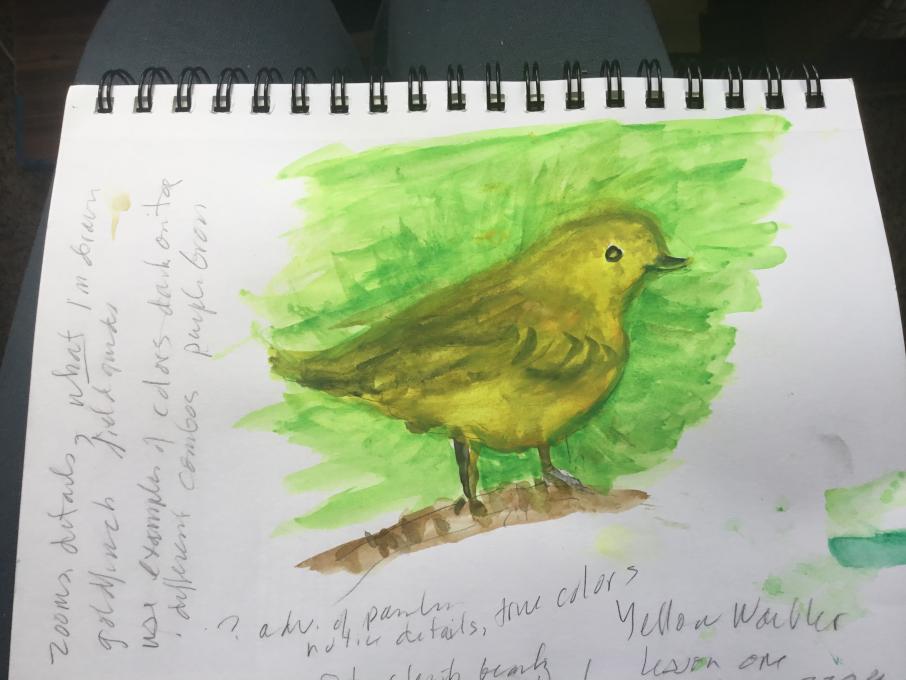
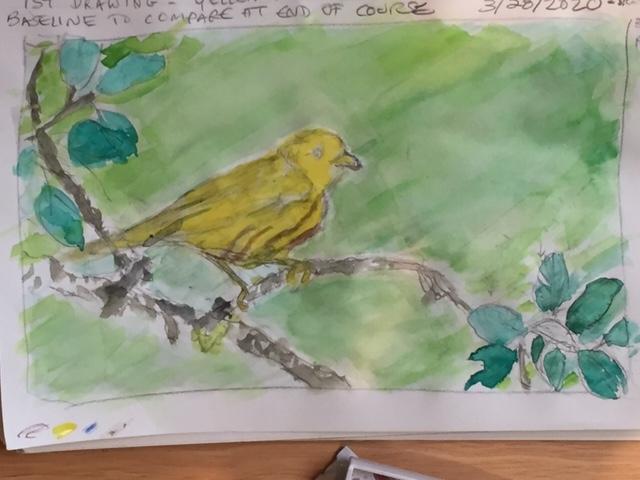 First a note to my fellow students who have replied. I am truly inspired to learn where you are and why you are taking the class. Thank you, all of you, for sharing your thoughts. It's so exciting to know we are from all over the world and sharing this connection. May you fare well in this surrealistic time.
It is very reassuring and inspiring to see everyone’s work!
I enjoyed drawing from the photo. I drew on 4 different days. First a sketch, next a background watercolor wash. Then I did two days of green and yellow. The original pencil helped with some grey tones on the shoulder and parts of the wings. The top photo is of the 2nd to the last painting day, while the bottom photo is my epiphany day.
I used the strategy of looking for geometric patterns of distribution on the whole photo, and parts of the bird and trees. I found though I started with overall shapes, I was identifying smaller and smaller shapes without end! I also had trouble judging the spatial relationships and proportions.
I did the first drawing on 3/28, and now it is 4/4. I realized I'm procrastinating about "completing" this assignment because the work is so "unfinished."
Then I had the revelation that my goal is to make progress towards learning more about sketching from nature and refining my sketching, coloring, and watercolor painting skills.
I also tried sketching some birds at my bird feeder, and realized that I need a lot of practice to hold an image in my memory long enough to sketch even a part of a bird because they move quickly, even at a bird feeder.
First a note to my fellow students who have replied. I am truly inspired to learn where you are and why you are taking the class. Thank you, all of you, for sharing your thoughts. It's so exciting to know we are from all over the world and sharing this connection. May you fare well in this surrealistic time.
It is very reassuring and inspiring to see everyone’s work!
I enjoyed drawing from the photo. I drew on 4 different days. First a sketch, next a background watercolor wash. Then I did two days of green and yellow. The original pencil helped with some grey tones on the shoulder and parts of the wings. The top photo is of the 2nd to the last painting day, while the bottom photo is my epiphany day.
I used the strategy of looking for geometric patterns of distribution on the whole photo, and parts of the bird and trees. I found though I started with overall shapes, I was identifying smaller and smaller shapes without end! I also had trouble judging the spatial relationships and proportions.
I did the first drawing on 3/28, and now it is 4/4. I realized I'm procrastinating about "completing" this assignment because the work is so "unfinished."
Then I had the revelation that my goal is to make progress towards learning more about sketching from nature and refining my sketching, coloring, and watercolor painting skills.
I also tried sketching some birds at my bird feeder, and realized that I need a lot of practice to hold an image in my memory long enough to sketch even a part of a bird because they move quickly, even at a bird feeder.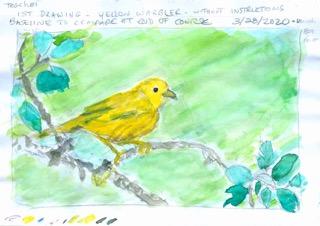
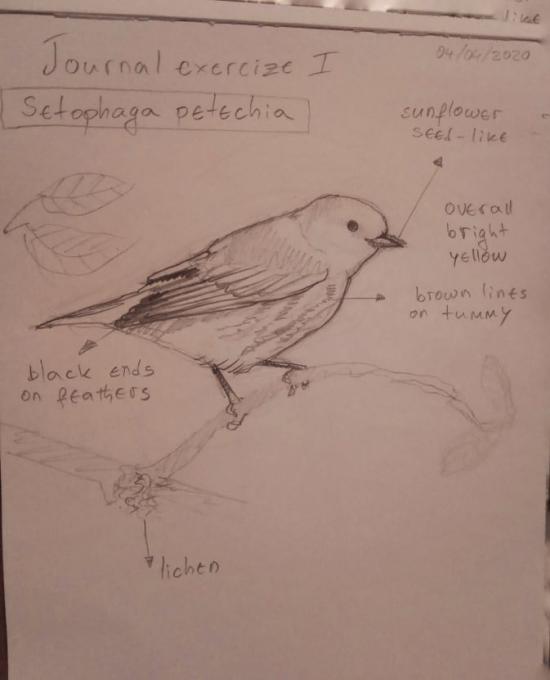 I wouldn't have notices the brownish patches if I didn't have to draw it.
I wouldn't have notices the brownish patches if I didn't have to draw it. 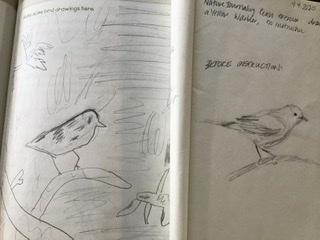 My 6yo son is taking this class with me! He said the photo made him feel like he was outside. For him, the easy part of the drawing was the background and the challenging part was the bird because of the feathers and the tail. For me, drawing from the photo gave me a chance to really look at the Warbler instead of trying to draw it like I thought it should look. I felt the easiest part was trying to get the general shape of the bird, but the most challenging part was to shade the markings, especially tying to distinguish between the black and brown markings. I never would have really looked at how the bird’s feet were gripping the branch if I had not had a photo to look at. Out in nature, I am sure I would never have noticed small details, as there just wouldn’t be the time.
My 6yo son is taking this class with me! He said the photo made him feel like he was outside. For him, the easy part of the drawing was the background and the challenging part was the bird because of the feathers and the tail. For me, drawing from the photo gave me a chance to really look at the Warbler instead of trying to draw it like I thought it should look. I felt the easiest part was trying to get the general shape of the bird, but the most challenging part was to shade the markings, especially tying to distinguish between the black and brown markings. I never would have really looked at how the bird’s feet were gripping the branch if I had not had a photo to look at. Out in nature, I am sure I would never have noticed small details, as there just wouldn’t be the time. 
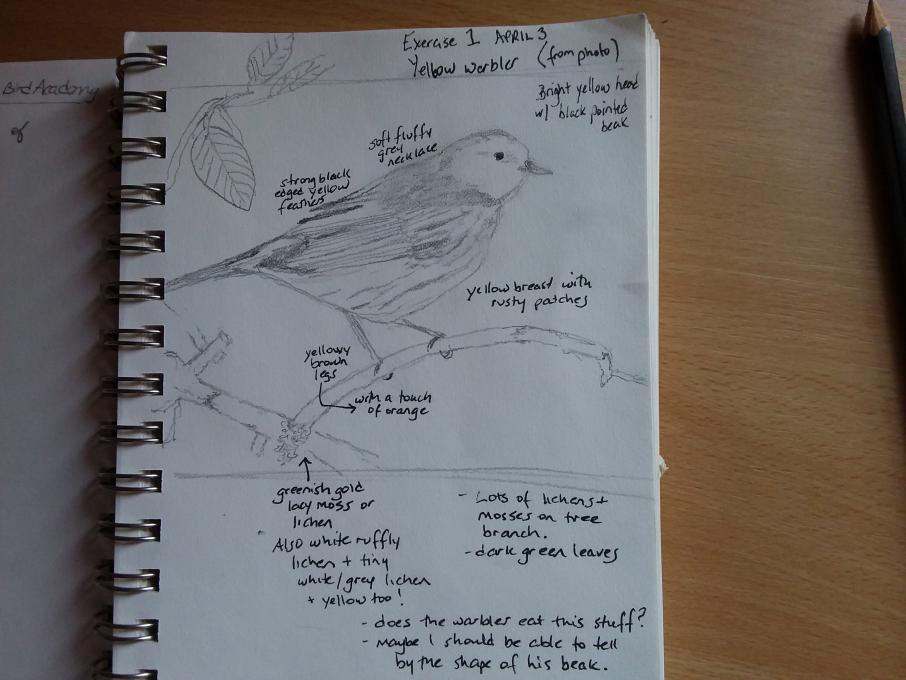 An interesting start. Working from a photo gives the luxury of time that I doubt we would have in the field! Good practice, all the same.
An interesting start. Working from a photo gives the luxury of time that I doubt we would have in the field! Good practice, all the same. 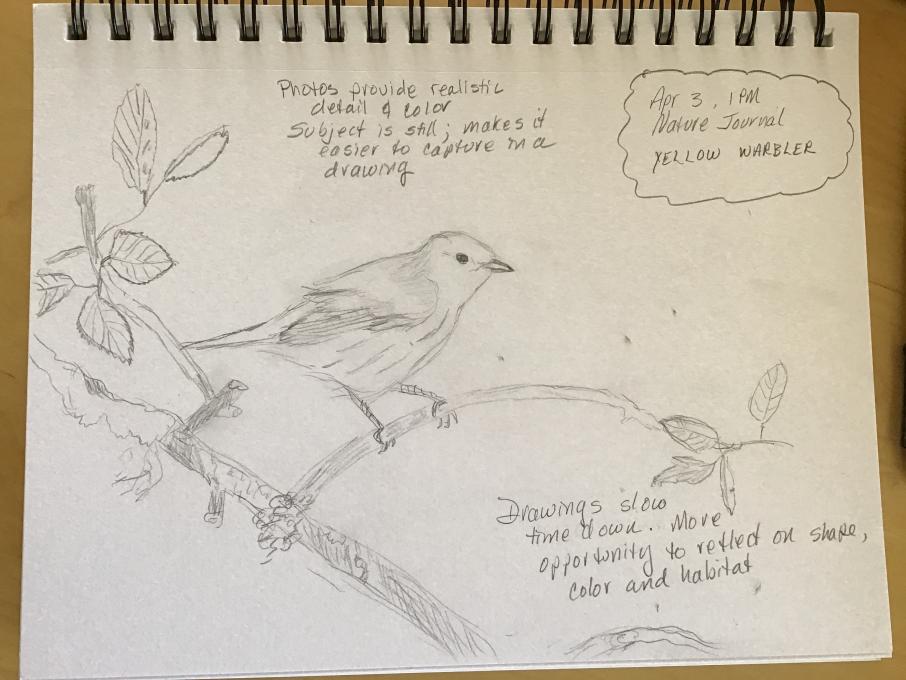
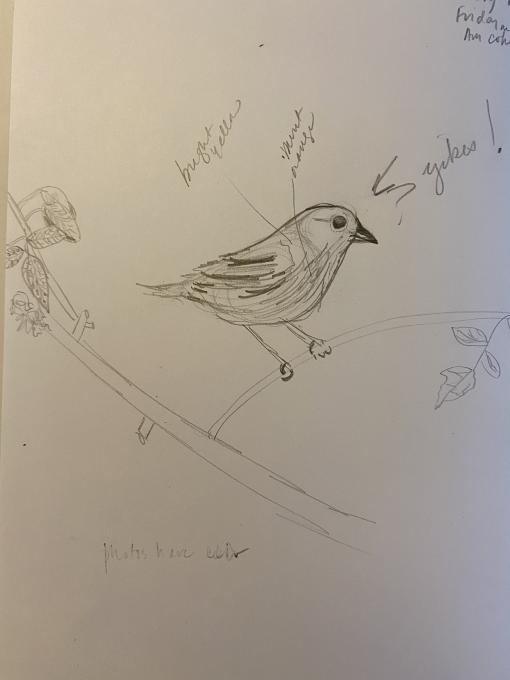
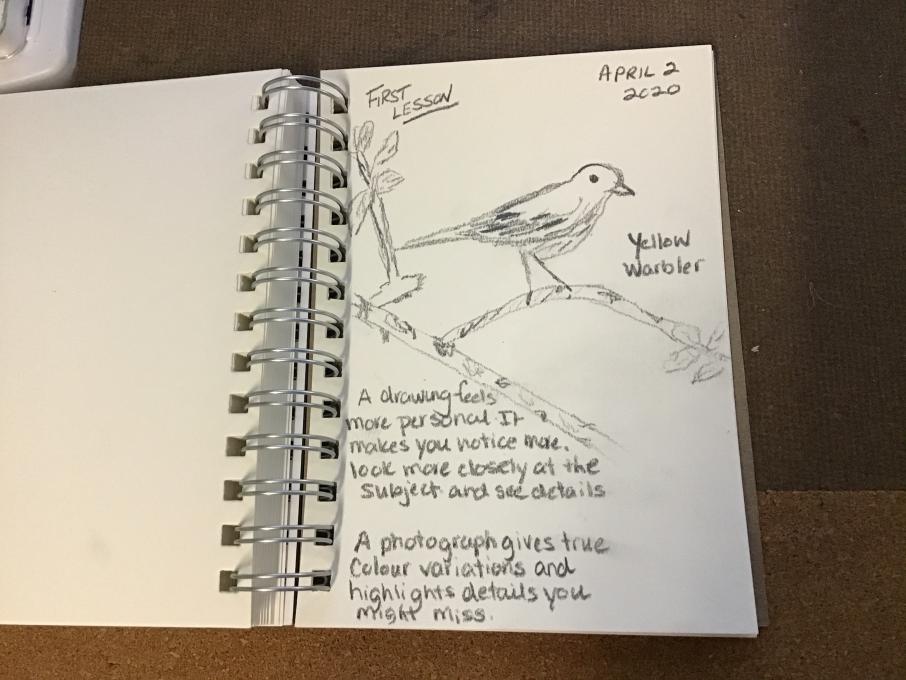
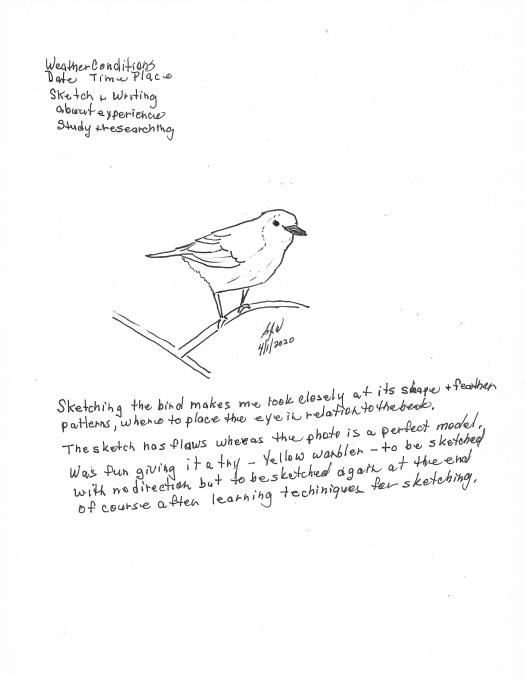 My late night try at the little yellow warbler. I wrote my comments on my sketch page actually. Thanks for the opportunity to share.
My late night try at the little yellow warbler. I wrote my comments on my sketch page actually. Thanks for the opportunity to share. 
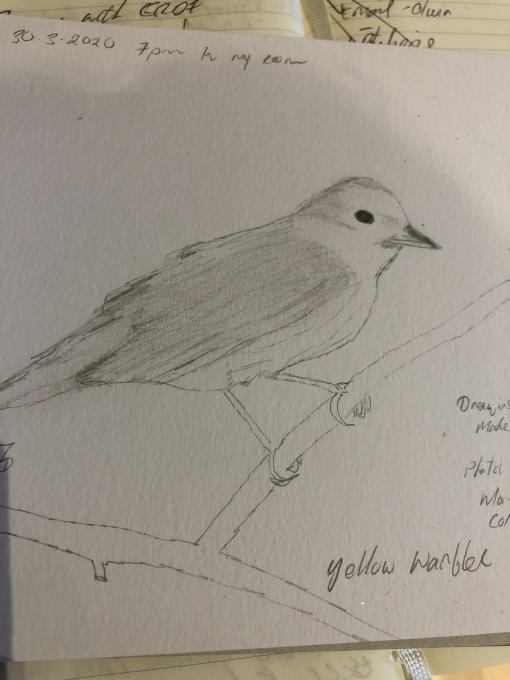
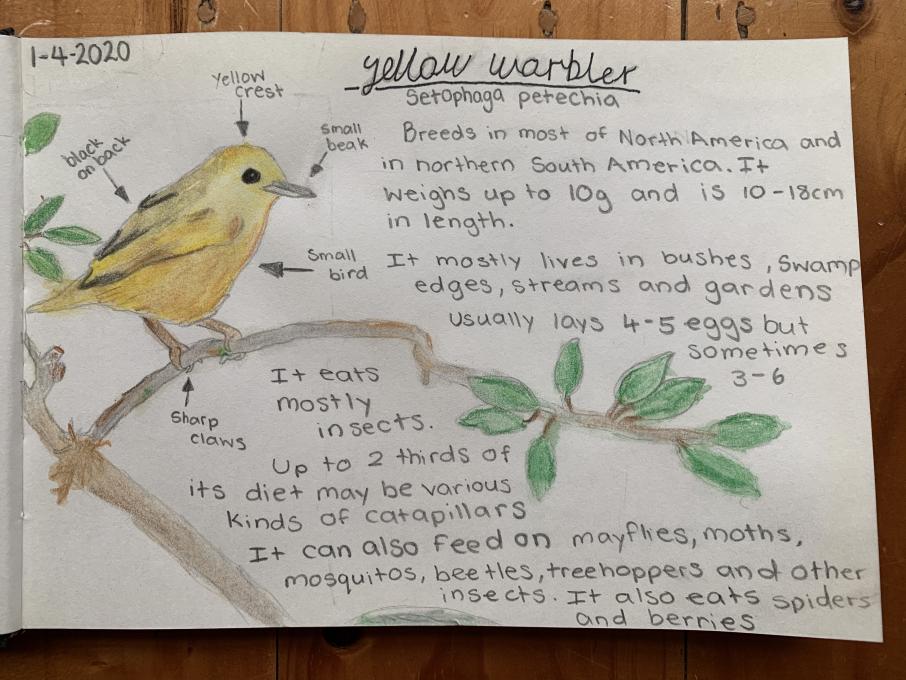 I really enjoyed this activity. I am learning from home because the schools have closed and this will be my art project. It was challenging to do it with no instructions. I can’t wait to get outside and start drawing.
I really enjoyed this activity. I am learning from home because the schools have closed and this will be my art project. It was challenging to do it with no instructions. I can’t wait to get outside and start drawing. 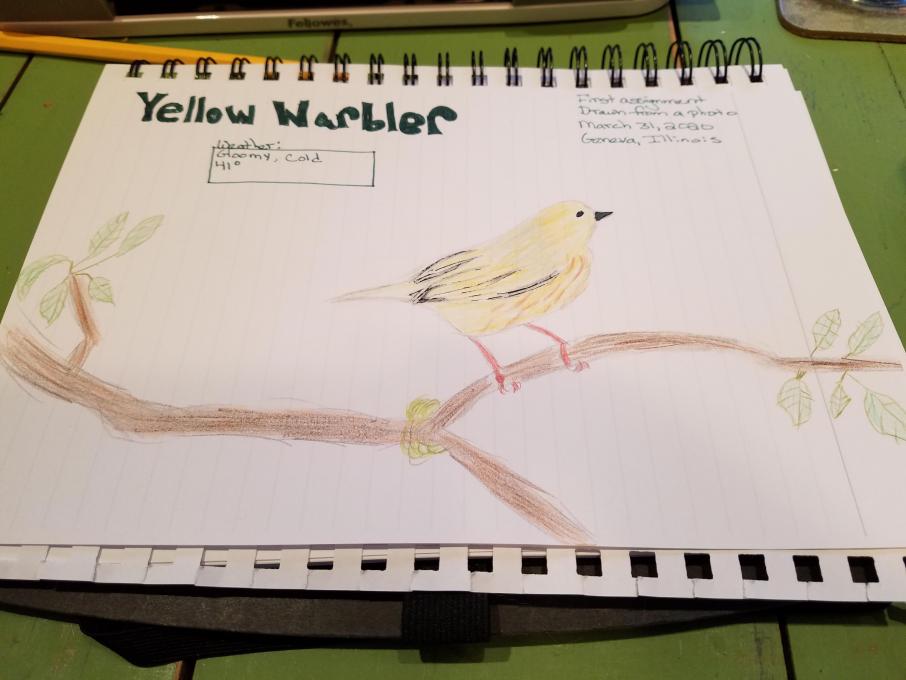
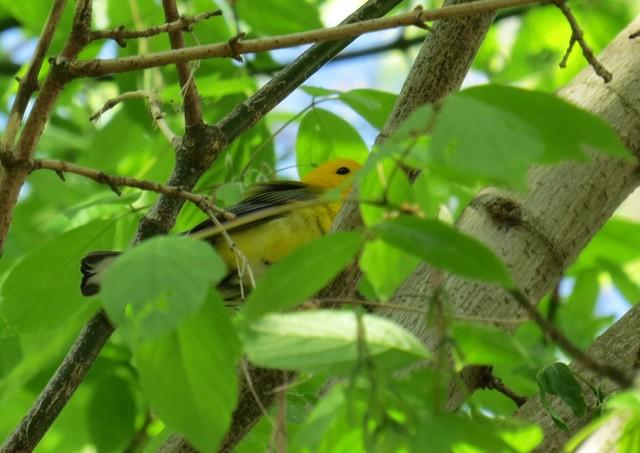
 This was a really fun exercise, and I can't wait to learn techniques and tricks to make my drawings come to life. My main take-away was that it's going to be much more challenging to draw a creature as when we see it in nature, because I had to refer back to the photo dozens and dozens of times to try to get it right!
This was a really fun exercise, and I can't wait to learn techniques and tricks to make my drawings come to life. My main take-away was that it's going to be much more challenging to draw a creature as when we see it in nature, because I had to refer back to the photo dozens and dozens of times to try to get it right! 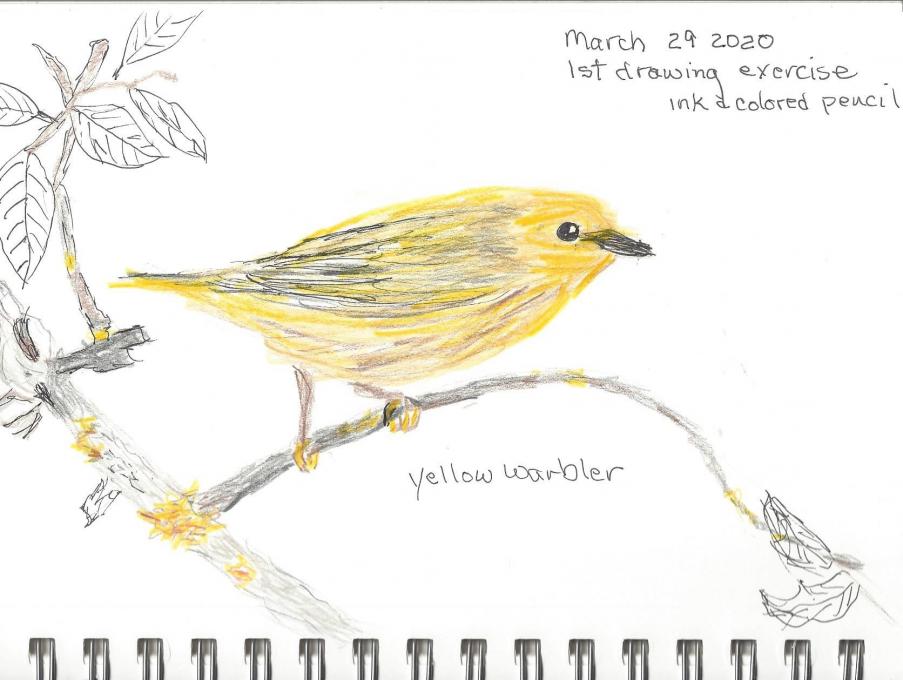 It was very difficult to get the shape just right. Oh and the beak is terrible. I hope I improve. I used some colored pencils but am looking forward to using water colors. More and more subtle colors are needed. I could see the details but just couldn't duplicate them. However, I have to say I liked the challenge.
It was very difficult to get the shape just right. Oh and the beak is terrible. I hope I improve. I used some colored pencils but am looking forward to using water colors. More and more subtle colors are needed. I could see the details but just couldn't duplicate them. However, I have to say I liked the challenge. 